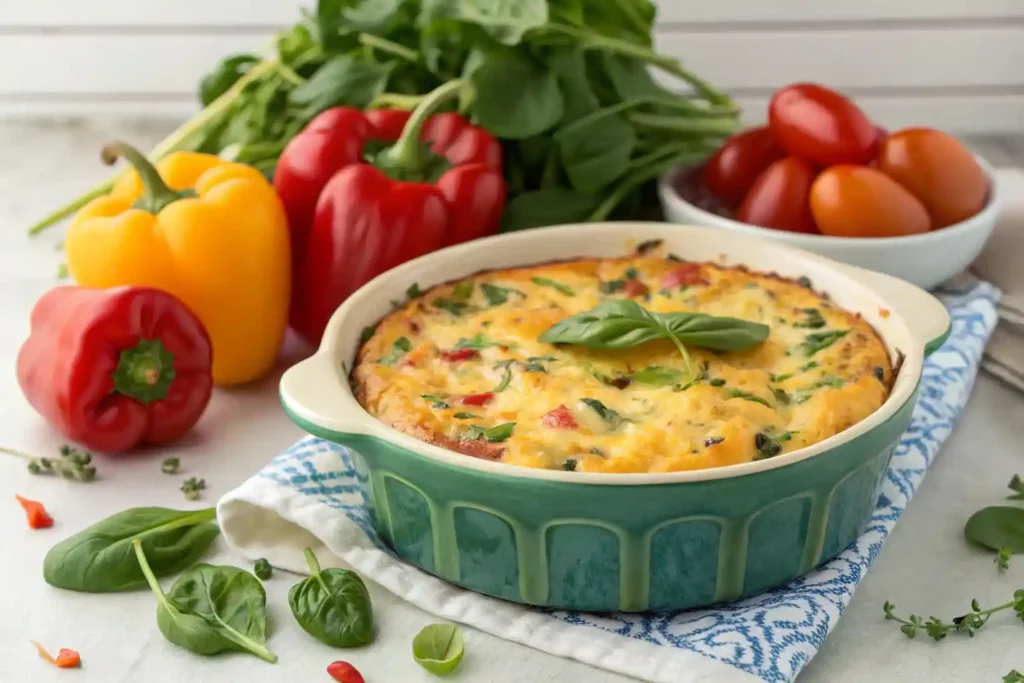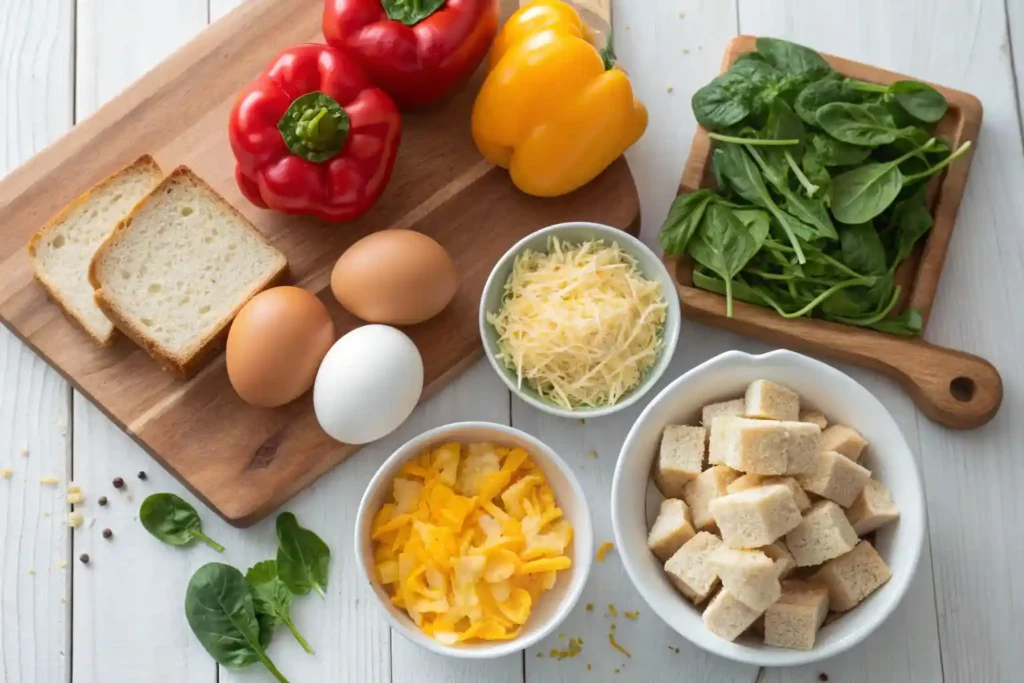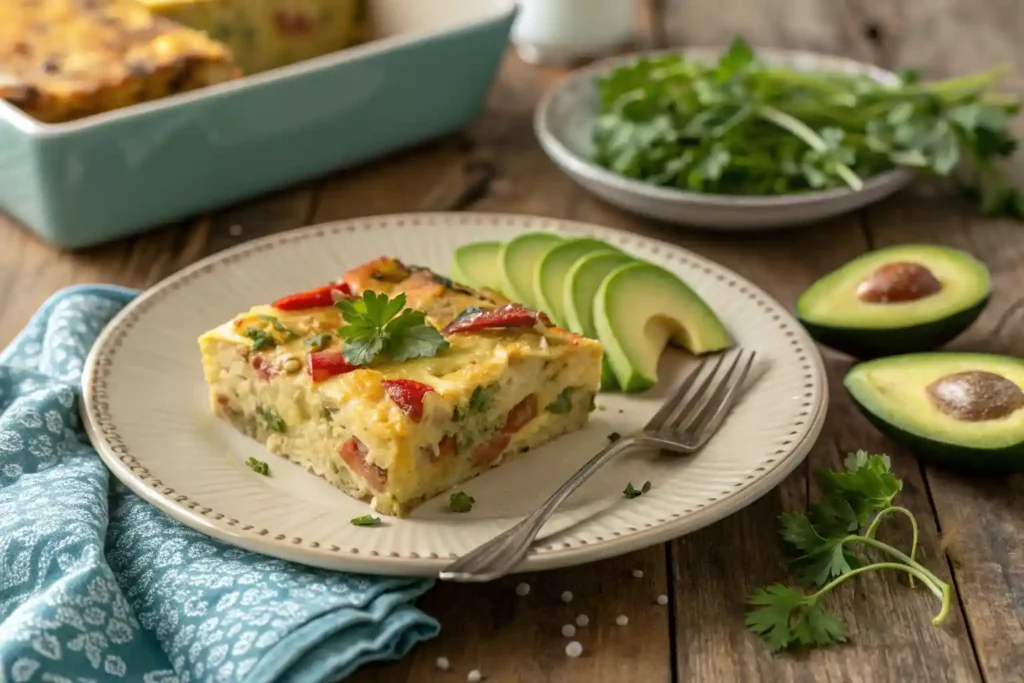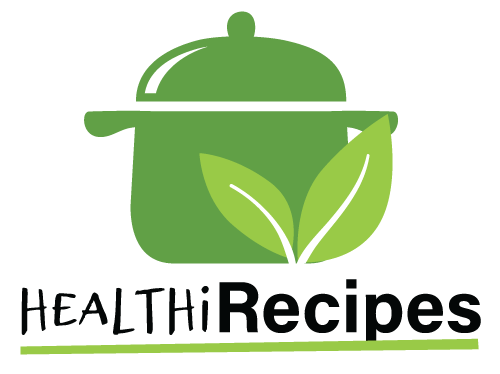Start your day right with these healthy gluten free breakfast casserole ideas! Packed with nutritious ingredients, these recipes are perfect for busy mornings and cater to various dietary preferences, ensuring everyone can enjoy a delicious breakfast.

Table of contents
1. What is a Gluten Free Breakfast Casserole?
A gluten-free breakfast casserole is a versatile dish that combines various ingredients baked together, making it a convenient and hearty meal option. Moreover, understanding its components can help you create a delicious and healthy breakfast.
1.1 Definition of a Breakfast Casserole
In general, a breakfast casserole is typically a baked dish that includes eggs, vegetables, and protein. Additionally, it can be prepared in advance, making it ideal for busy mornings or family gatherings. Furthermore, the gluten-free version substitutes traditional ingredients with gluten-free alternatives.
1.2 Benefits of Making it Gluten-Free
Firstly, gluten-free ingredients can be lower in calories and higher in nutrients, offering healthier options. Moreover, for those with gluten sensitivities or celiac disease, gluten-free casseroles prevent discomfort, promoting digestive health. Lastly, you can experiment with different ingredients, ensuring a unique dish every time.
1.3 Common Ingredients Used
To begin with, eggs are the primary binding ingredient, providing protein and richness. In addition, vegetables like spinach, bell peppers, and onions add flavor and nutrients. Finally, grains such as quinoa or gluten-free bread can serve as a base, adding texture and fiber.
2. Healthy Ingredients for Your Breakfast Casserole
Choosing the right ingredients is crucial for creating a healthy gluten free breakfast casserole. Here are some key components to consider when preparing your dish.
2.1 Protein Sources
- Eggs: A staple in breakfast casseroles, eggs provide essential protein and can be substituted with egg alternatives for vegan options.
- Gluten-Free Sausage or Bacon: Look for brands that specifically label their products as gluten-free to ensure safety.
- Tofu: A great plant-based protein option that can be seasoned and crumbled into the casserole.
2.2 Vegetables
- Spinach: Packed with vitamins and minerals, spinach adds a nutritious boost.
- Bell Peppers: These colorful vegetables provide flavor and crunch, along with vitamin C.
- Onions and Mushrooms: Both add depth of flavor and are low in calories, making them excellent choices.
2.3 Grains and Alternatives
- Quinoa: A gluten-free grain that is high in protein and fiber, making it a great base for your casserole.
- Brown Rice: Another healthy option that adds texture and is gluten-free.
- Gluten-Free Bread: Use gluten-free bread cubes for a traditional casserole texture.
3. Recipe: Gluten Free Breakfast Casserole

Now that you understand the components of a healthy gluten free breakfast casserole, let’s dive into a simple and delicious recipe that you can easily prepare at home.
3.1 Ingredients
- 6 large eggs (or egg substitute)
- 1 cup milk (dairy or non-dairy)
- 2 cups fresh spinach, chopped
- 1 bell pepper, diced
- 1 onion, diced
- 1 cup gluten-free sausage, cooked and crumbled
- 1 cup shredded cheese (optional, use dairy-free cheese for a vegan option)
- Salt and pepper to taste
- 1 teaspoon garlic powder (optional)
- 1 cup cooked quinoa (or gluten-free bread cubes)
3.2 Directions
- Preheat the Oven: Preheat your oven to 350°F (175°C).
- Prepare the Baking Dish: Grease a 9×13-inch baking dish with cooking spray or olive oil.
- Mix Ingredients: In a large bowl, whisk together the eggs and milk. Add salt, pepper, and garlic powder. Stir in the spinach, bell pepper, onion, sausage, cheese, and quinoa.
- Pour into Dish: Pour the mixture into the prepared baking dish, spreading it evenly.
- Bake: Bake for 30-35 minutes, or until the casserole is set and lightly golden on top.
- Cool and Serve: Allow it to cool for a few minutes before slicing. Serve warm.
3.3 Tips for Making the Perfect Breakfast Casserole
- Avoiding a Soupy Casserole: Ensure that you don’t add too much liquid. If using frozen vegetables, thaw and drain them before adding.
- Meal Prep Tips: Prepare the casserole the night before and refrigerate it. Just pop it in the oven in the morning for a quick breakfast.
- Reheating Instructions: To reheat, cover with foil and warm in the oven at 350°F (175°C) for about 15-20 minutes.
4. Tips for Making the Perfect Breakfast Casserole

Creating a healthy gluten free breakfast casserole is not just about the ingredients; it’s also about the technique. Here are some essential tips to ensure your casserole turns out perfectly every time.
4.1 Avoiding a Soupy Casserole
- Use Fresh Ingredients: Fresh vegetables contain less moisture than frozen ones. If you use frozen vegetables, make sure to thaw and drain them thoroughly.
- Don’t Overdo the Liquid: Stick to the recommended amounts of milk or broth. Too much liquid can lead to a soggy casserole.
- Cook Vegetables First: Sautéing vegetables before adding them to the casserole can help reduce moisture and enhance their flavors.
4.2 Meal Prep Tips
- Make Ahead: Prepare your casserole the night before. Simply mix all the ingredients, pour them into the baking dish, cover, and refrigerate overnight. In the morning, bake it straight from the fridge, adding a few extra minutes to the cooking time.
- Portion Control: Consider making individual servings in muffin tins for easy grab-and-go breakfasts. This method also allows for different flavor combinations in each portion.
- Freezing Options: You can freeze leftovers in individual portions. Wrap them tightly in plastic wrap and then in aluminum foil. When ready to eat, thaw overnight in the fridge and reheat in the oven.
4.3 Reheating Instructions
- Oven Method: Preheat your oven to 350°F (175°C). Cover the casserole with foil to prevent it from drying out and heat for about 15-20 minutes.
- Microwave Method: For a quicker option, microwave individual portions on medium power for 1-2 minutes, checking to ensure it’s heated through.
- Avoid Overheating: Be careful not to overheat, as this can lead to a rubbery texture. Heat just until warmed through.
5. Gluten Free Breakfast Ideas Beyond Casseroles
While gluten free breakfast casseroles are delicious and convenient, it’s always good to have a variety of breakfast options. Here are some alternatives that are equally healthy and satisfying.
5.1 Alternatives for Breakfast
- Smoothies: Blend your favorite fruits, spinach, and a scoop of protein powder for a quick, nutritious breakfast. Add almond milk or yogurt for creaminess.
- Oatmeal: Use gluten-free oats and top with fruits, nuts, and a drizzle of honey or maple syrup. This is a warm, comforting option that’s easy to customize.
- Chia Pudding: Mix chia seeds with almond milk and let it sit overnight. In the morning, add fruits and nuts for a nutritious breakfast.
5.2 Quick and Easy Options
- Yogurt Parfaits: Layer gluten-free granola, yogurt, and fresh fruit for a quick breakfast that’s tasty and looks great.
- Breakfast Burritos: Use gluten-free tortillas filled with scrambled eggs, cheese, and your choice of veggies. Wrap them up and enjoy on the go.
- Avocado Toast: Spread smashed avocado on gluten-free bread, add a pinch of salt, and top with your favorite items like tomatoes or poached eggs.
5.3 Incorporating Hashbrowns
- Are Breakfast Hashbrowns Gluten-Free?: Yes, most hashbrowns are naturally gluten-free, but always check the label for any added ingredients that might contain gluten.
- Homemade Hashbrowns: Grate potatoes, squeeze out extra moisture, and fry them in a pan until crispy. They can be added to your breakfast casserole for extra crunch.
- Sweet Potato Hashbrowns: For a healthier option, use sweet potatoes. They add natural sweetness and are full of nutrients.
6. Frequently Asked Questions (FAQs)
As you explore the world of healthy gluten free breakfast casseroles, you may have some questions. Here are answers to common queries that can help you in your cooking journey.
6.1 What is a good egg substitute for gluten free cupcakes?
- Flaxseed Meal: Mix 1 tablespoon of flaxseed meal with 2.5 tablespoons of water and let it sit for 5 minutes. This mixture works well as a binding agent.
- Applesauce: Use 1/4 cup of unsweetened applesauce for each egg. This adds moisture and sweetness.
- Silken Tofu: Blend 1/4 cup of silken tofu until smooth to replace one egg in recipes.
6.2 Are breakfast hashbrowns gluten free?
- Yes, most hashbrowns are made from potatoes and are gluten-free. However, always check the label for any added ingredients or cross-contamination warnings.
6.3 What can I eat for breakfast if I can’t eat eggs or gluten?
- Smoothies: Packed with fruits and vegetables, smoothies are a great alternative.
- Oatmeal: Use gluten-free oats and top with your favorite fruits and nuts.
- Chia Pudding: A nutritious option that can be made without eggs.
6.4 How do you reheat breakfast casserole?
- Oven: Preheat to 350°F (175°C), cover with foil, and heat for 15-20 minutes.
- Microwave: Heat individual portions on medium power for 1-2 minutes.
6.5 How long can a breakfast casserole be refrigerated before baking?
- You can refrigerate an unbaked breakfast casserole for up to 24 hours. If you need to store it longer, consider freezing it.
6.6 Why is my breakfast casserole soupy?
- A soupy casserole can result from too much liquid or using frozen vegetables without draining them. Ensure you follow the recipe’s liquid measurements and use fresh ingredients when possible.
7. Conclusion
In conclusion, healthy gluten free breakfast casseroles are a fantastic way to start your day. They are not only delicious but also versatile, allowing you to customize them according to your dietary needs and preferences. Here’s a quick recap of what we’ve covered:
7.1 Recap of the Benefits
- Nutrient-Dense: Packed with proteins, vegetables, and healthy fats, these casseroles provide a balanced meal.
- Convenient: They can be prepared in advance, making them perfect for busy mornings or family gatherings.
- Versatile: With endless ingredient combinations, you can create a new dish every time.
7.2 Encouragement to Try the Recipes
We encourage you to experiment with different ingredients and flavors. Whether you prefer a classic egg and cheese casserole or a veggie-packed version, there’s a recipe for everyone. Don’t hesitate to share your creations and variations with friends and family!
7.3 Invitation for Reader Engagement
We’d love to hear your thoughts! What are your favorite ingredients for a breakfast casserole? Have you tried any of the recipes mentioned? Share your experiences in the comments below, and let’s inspire each other to create delicious gluten-free breakfasts!
For more delicious breakfast ideas, check out our guide on Easy High Protein Breakfast Options to complement your casseroles. If you’re looking for something different, explore our article on Healthy Enchiladas: Guilt-Free for a unique twist on breakfast. Lastly, don’t miss our insights on Best Breakfast Meats: Hearty Meal to add protein-packed options to your morning routine.
Thank you for reading, and happy cooking!
8. Additional Resources and Tips
To further enhance your breakfast casserole experience, consider these additional resources and tips:
8.1 Recommended Cookbooks
- “Gluten-Free Breakfasts”: A cookbook with breakfast recipes for gluten-free diets.
- “The Complete Gluten-Free Cookbook”: This book has many gluten-free recipes, including breakfast casseroles.
8.2 Online Communities
- Gluten-Free Forums: Join online groups where you can share recipes, tips, and stories with others who eat gluten-free.
- Social Media Groups: Follow gluten-free cooking groups on sites like Facebook and Instagram for ideas and support.
8.3 Cooking Classes
- Local Cooking Classes: Look for classes that teach gluten-free cooking. This can be a fun way to learn new skills and recipes.
- Online Cooking Workshops: Many chefs offer online classes that focus on gluten-free meals, so you can learn from home.
9. Final Thoughts
As you embark on your journey to create healthy gluten free breakfast casseroles, remember that cooking should be enjoyable and creative. Don’t be afraid to experiment with flavors and textures. The key is to find what works best for you and your family.
9.1 Embrace the Process
Cooking is an art, and every dish is an opportunity to express your creativity. Embrace the process, and don’t stress about perfection. Each casserole you make will teach you something new.
9.2 Share Your Journey
Share your successes and challenges with others. Whether it’s through social media or in-person gatherings, connecting with fellow food enthusiasts can enhance your cooking experience.
9.3 Enjoy Your Meals
Finally, take the time to enjoy your meals. A healthy breakfast sets a positive tone for the day, so savor each bite of your delicious gluten-free casserole.

